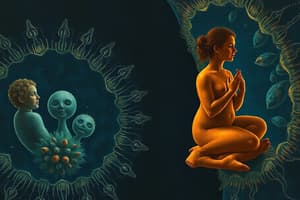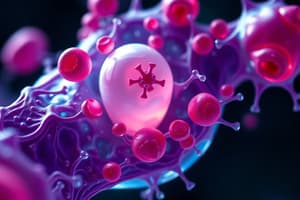Podcast
Questions and Answers
কোন কোষ অঙ্গাণু সাইটে প্রোটিন সংশ্লেষণ হয়?
কোন কোষ অঙ্গাণু সাইটে প্রোটিন সংশ্লেষণ হয়?
- রাইবোসোম (correct)
- মাইটোকন্ড্রিয়া
- গলজি অ্যাপারেটাস
- লিসোসোম
উদ্ভিদে খাদ্য সংশ্লেষণের প্রক্রিয়া কি?
উদ্ভিদে খাদ্য সংশ্লেষণের প্রক্রিয়া কি?
- এক্সক্রিশন
- ডাইজেস্টিভ সিস্টেম
- ফটোসিন্থেসিস (correct)
- রেসপিরেশন
প্রাণীদের মধ্যে খাদ্য গ্রহণের ধরন কি?
প্রাণীদের মধ্যে খাদ্য গ্রহণের ধরন কি?
- মাইক্সোট্রফিক পুষ্টি
- অটোট্রফিক পুষ্টি
- হেটেরোট্রফিক পুষ্টি (correct)
- হাইপারট্রফিক পুষ্টি
Flashcards are hidden until you start studying
Study Notes
Cell: The Basic Unit of Life
- Cell: the smallest structural and functional unit of life
- All living organisms are composed of one or more cells
- Cell membrane: thin, semi-permeable membrane that surrounds the cell
- Cell wall: rigid, outer layer that provides support and protection (found in plant cells)
Cell Organelles
- Nucleus: control center of the cell, contains genetic material (DNA)
- Mitochondria: site of cellular respiration, generates energy for the cell
- Endoplasmic reticulum (ER): network of membranous tubules and cisternae, involved in protein synthesis and transport
- Ribosomes: site of protein synthesis, found in the cytoplasm and attached to the ER
- Lysosomes: membrane-bound sacs that contain digestive enzymes, involved in cellular digestion and recycling
- Golgi apparatus: complex of flattened sacs and tubules, involved in protein modification and transport
Tissues
- A group of similar cells that perform a specific function
- Types of tissues:
- Epithelial tissue: forms the lining of organs and glands
- Connective tissue: provides support and connectivity to the body
- Muscular tissue: involved in movement and contraction
- Nervous tissue: responsible for transmitting and processing information
Organ Systems
- A group of organs that work together to perform a specific function
- Examples of organ systems:
- Circulatory system: transports oxygen and nutrients to cells, and waste products away from cells
- Respiratory system: brings oxygen into the body and removes carbon dioxide
- Nervous system: transmits and processes information
- Digestive system: breaks down food into nutrients that can be absorbed and utilized by the body
Nutrition in Plants
- Autotrophic nutrition: plants produce their own food through photosynthesis
- Photosynthesis: process by which plants convert light energy into chemical energy
- Factors affecting photosynthesis:
- Light
- Water
- Carbon dioxide
- Temperature
- Chlorophyll
Nutrition in Animals
- Heterotrophic nutrition: animals obtain their food by consuming other organisms or plants
- Types of nutrition in animals:
- Herbivores: plant-eaters
- Carnivores: meat-eaters
- Omnivores: eat both plants and animals
- Digestive system: breakdown of food into nutrients that can be absorbed and utilized by the body
Transportation in Plants and Animals
- Transportation in plants:
- Xylem: transports water and minerals from roots to leaves
- Phloem: transports sugars and other organic compounds from leaves to roots
- Transportation in animals:
- Blood: transports oxygen, nutrients, and waste products throughout the body
- Lymphatic system: helps to defend the body against disease and infection
Excretion in Plants and Animals
- Excretion in plants:
- Transpiration: process by which plants release excess water into the environment
- Excretion of waste products: occurs through the roots and leaves
- Excretion in animals:
- Kidneys: filter waste products from the blood and excrete them in the urine
- Liver: detoxifies the blood and excretes bile into the digestive system
- Skin: excretes sweat and other waste products
Respiration in Plants and Animals
- Respiration in plants:
- Cellular respiration: process by which plants generate energy from glucose
- Release of oxygen and carbon dioxide: occurs through the stomata and roots
- Respiration in animals:
- Breathing: process by which animals take in oxygen and release carbon dioxide
- Cellular respiration: process by which animals generate energy from glucose
কোষ: জীবনের মৌলিক একক
- কোষ: জীবনের সবচেয়ে ছোট গঠনগত ও কার্যগত একক
- সকল জীবন্ত জীব এক বা একাধিক কোষ দ্বারা গঠিত
কোষ অঙ্গাণু
- নিউক্লিয়াস: কোষের নিয়ন্ত্রণ কেন্দ্র, ডিএনए ধারণ করে
- মাইটোকন্ড্রিয়া: কোষের শক্তি উৎপাদনের স্থান
- এন্ডোপ্লাজমিক রেটিকুলাম: প্রোটিন সংশ্লেষণ ও পরিবহনে জড়িত
- রাইবোসোম: প্রোটিন সংশ্লেষণের স্থান, সাইটোপ্লাজম ও এন্ডোপ্লাজমিক রেটিকুলামে অবস্থিত
- লাইসোসোম: অন্তর্ভুক্ত এনজাইম ধারণকারী স্যাক, কোষীয় পরিপাক ও পুনর্ব্যবহারে জড়িত
- গলজি অ্যাপারেটাস: প্রোটিন পরিবর্তন ও পরিবহনে জড়িত
টিসু
- একই কাজ করার জন্য একত্রে থাকা কোষসমূহ
- টিসুর প্রকার:
- এপিথিলিয়াল টিসু: অঙ্গ ও গ্রন্থির আবরণ গঠন করে
- কনেক্টিভ টিসু: শরীরের সংযোজন ও সহায়তা প্রদান করে
- মাসকুলার টিসু: সঞ্চালন ও সংকোচনে জড়িত
- নার্ভাস টিসু: তথ্য সঞ্চার ও প্রক্রিয়াকরণে জড়িত
অঙ্গ সিস্টেম
- একত্রে কাজ করা অঙ্গসমূহ
- অঙ্গ সিস্টেমের উদাহরণ:
- সার্কুলেটরি সিস্টেম: অক্সিজেন ও পুষ্টি কোষে পরিবহন করে এবং বর্জ্য পদার্থ কোষ থেকে দূরে সরিয়ে নেয়
- রেসপিরেটরি সিস্টেম: শরীরে অক্সিজেন আনয়ন ও কার্বন ডাই অক্সাইড বার করে
- নার্ভাস সিস্টেম: তথ্য সঞ্চার ও প্রক্রিয়াকরণে জড়িত
- ডাইজেস্টিভ সিস্টেম: খাদ্য পরিপাক করে শরীরের পুষ্টির জন্য উপযোগী করে
উদ্ভিদের পুষ্টি
- স্বয়ংসম্পূর্ণ পুষ্টি: উদ্ভিদ নিজস্ব খাদ্য উৎপাদন করে
- ফটোসিন্থেসিস: আলোর শক্তি রাসায়নিক শক্তিতে রূপান্তর করে
- ফটোসিন্থেসিসে প্রভাব ফেলা উপাদান:
- আলো
- জল
- কার্বন ডাই অক্সাইড
- তাপমাত্রা
- ক্লোরোফিল
প্রাণীর পুষ্টি
- পরানুগ পুষ্টি: প্রাণী অন্য জীব বা উদ্ভিদ খাদ্য গ্রহণ করে
- প্রাণীর পুষ্টির প্রকার:
- হারবিভোর: উদ্ভিদ ভক্ষক
- কার্নিভোর: মাংস ভক্ষক
- অমনিভোর: উদ্ভিদ ও মাংস ভক্ষক
পরিবহন ও অপসারণ
- উদ্ভিদের পরিবহন:
- জাইলেম: জল ও খনিজ পদার্থ মূল থেকে পাতা পর্যন্ত পরিবহন করে
- ফ্লোইম: চিনি ও
Studying That Suits You
Use AI to generate personalized quizzes and flashcards to suit your learning preferences.




